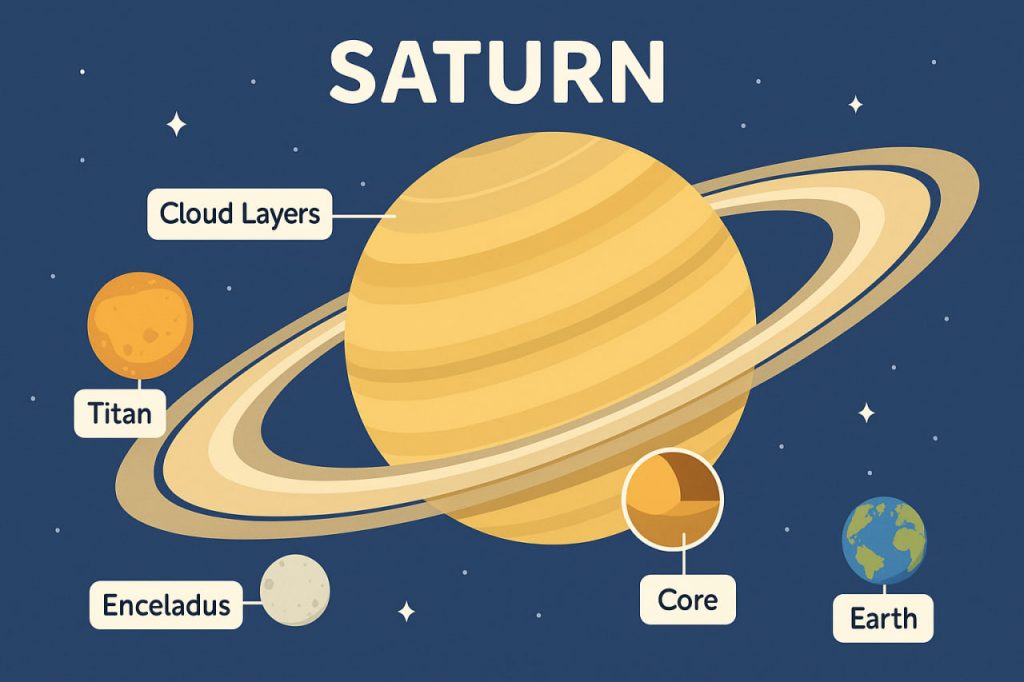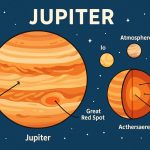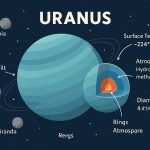Saturn is the sixth planet from the Sun and the second-largest in our Solar System. It is best known for its spectacular ring system, which sets it apart from all other planets. A gas giant composed mostly of hydrogen and helium, Saturn is a planet of extremes—featuring fast winds, a low average density, and over 100 fascinating moons.
Basic Characteristics of Saturn
- Distance from the Sun: ~1.43 billion km (9.5 AU)
- Diameter: ~120,500 km (about 9.5 times Earth’s)
- Length of day: ~10.7 hours
- Length of year: ~29.5 Earth years
- Atmosphere: Hydrogen, helium, and trace gases like methane and ammonia
- Average temperature: ~ -178°C (-288°F)
- Rings: Made of ice, dust, and rock, stretching over 280,000 km wide but only ~10 meters thick
- Moons: Over 145 known, including Titan and Enceladus
The Famous Rings of Saturn
Saturn’s rings are its most iconic feature. While other gas giants have rings, Saturn’s are the most extensive and visible. They are divided into seven main sections named A through G and contain billions of particles ranging from dust-sized grains to house-sized chunks of ice.
Scientists believe the rings may have formed from the debris of a shattered moon or comet, and they might not last forever—gradually falling into Saturn due to gravitational drag.
Composition and Structure
Saturn is a gas giant without a solid surface. Its internal structure includes:
- Upper atmosphere: Fast winds (up to 1,800 km/h), clouds of ammonia crystals
- Deeper layers: Liquid hydrogen and helium
- Core: A dense center of rock, ice, and metals, possibly similar in size to Earth
Despite its size, Saturn has the lowest density of any planet—it could float in water.
Saturn’s Moons
Saturn’s moons are a world of their own:
- Titan: The second-largest moon in the Solar System, with a thick nitrogen-rich atmosphere and lakes of liquid methane
- Enceladus: An icy moon with geysers that shoot water vapor into space, hinting at a subsurface ocean that may harbor life
- Mimas, Rhea, Iapetus: Other diverse moons with unique geological features
These moons provide key insights into planetary formation and the potential for life beyond Earth.
Exploration of Saturn
- Pioneer 11, Voyager 1 & 2: First flybys in the late 1970s and early 1980s
- Cassini-Huygens (1997–2017): One of the most successful missions in planetary science. It orbited Saturn for 13 years, studied its rings and moons, and landed the Huygens probe on Titan
The Cassini mission revealed complex details about Saturn’s magnetic field, atmosphere, storms, and seasonal changes.
Saturn’s Role in the Solar System
Saturn’s massive gravitational influence shapes the structure of the outer Solar System. It helps protect the inner planets from comets and contributes to the balance of the planetary orbits.
Its moon system and ring dynamics are also used as models to understand how planets and moons formed in the early Solar System.
Conclusion
Saturn is not only beautiful but scientifically vital. With its stunning rings, diverse moons, and complex atmosphere, it remains one of the most studied and admired planets. Ongoing exploration may one day answer whether any of Saturn’s moons harbor life beneath their icy shells.
Glossary
- Gas Giant: A large planet made mostly of gas, lacking a solid surface
- Rings: Circular structures of ice and dust particles that orbit Saturn
- Titan: Saturn’s largest moon, with a dense atmosphere and methane lakes
- Enceladus: An icy moon with possible subsurface oceans
- Cassini Mission: NASA mission that explored Saturn from 2004 to 2017


